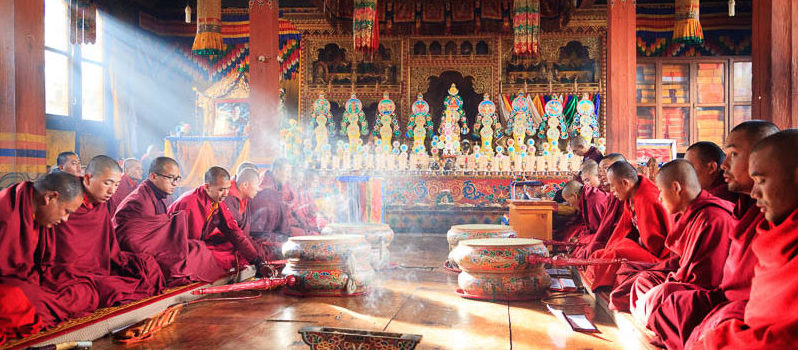Knowledge Networking Portal for Sustainable & Responsible Tourism










 The ONLY Carbon Negative Country in the World.
The ONLY Carbon Negative Country in the World.
 Nestling in the eastern Himalayas lies the hidden Kingdom of Bhutan.
Nestling in the eastern Himalayas lies the hidden Kingdom of Bhutan.
Bhutan is known to the outside world as the last Shangrila, this remote, mystical country is one of the last unspoiled places on the planet. Bhutan’s eco-system ranges from sub-tropical to alpine with a staggering 75 percent forest coverage. A population of less than a million, largely agrarian, live in small hamlets scattered along mountain slopes and riverine valleys.
Throughout its history, this land has chosen to remain in splendid isolation, a forbidden kingdom in the truest sense. Today, however, Bhutan welcomes the discerning traveler in search of a rare and precious experience. As its tourism industry is a little over two decades old.
Bhutan is still one of the world's most exclusive destinations, with the added incentive of its owning some of the most spectacular landscapes and trekking routes on earth.
The country's long geopolitical seclusion and its strong Buddhist ethic have together preserved what can only be described as a land where man lives in harmony with nature.
From the majestic ice-bound mountains in the north down to the lush tropical forests of the south, Bhutan encapsulates a wonderful natural diversity and when you add to that a large dose of fresh air and sparkling water with a dash of the unique art, architecture, and culture, and top it up with pleasant people, you're served up with a feast the like of which you'd have to travel far to find - so come visit Bhutan, the place where the thirst for nature, culture, and tradition with a difference is quenched.
Bhutan, nestling in the heart of the great Himalaya, has for centuries remained aloof from the rest of the world. Since its doors were cautiously opened in 1974, visitors have been mesmerized: the environment is pristine, the scenery and architecture awesome and the people hospitable and charming.
The beautiful and must-visit cities, towns, and villages in Bhutan are:
Reasons for visiting Bhutan are the many forts, fortresses, convents, monasteries and temples, the trekking paths, and the stunning nature, Bhutan has a great variety of bird species, flowers & plants, and forests (trees).
The stunning nature changes because of the height differences in Bhutan, the lowest point of Bhutan is about 100 meters above sea level and rises well above 7500 meters. Above 4000 meters there's no forest. Between 2000 to 4000 meters you will find beautiful forests and under the 2000 meter tropical or subtropical vegetation.
The forest types in Bhutan are:
- Fir Forests,
- Mixed Conifer forests,
- Blue Pine forests,
- Chirpine forests,
- Broadleaf mixed with Conifer,
- Upland Hardwood Forest,
- Lowland Hardwood Forest, and Tropical Lowland Forests.
Animals in Bhutan you will probably or hope to see are:
- Snow leopards (very rare),
- Bengal tigers, the red panda,
- Gorals, and the langurs,
- Himalayan black bear and sambars,
- The wild pigs and the barking deer,
- Blue sheep and the musk deer.
In the tropical forests of Southern Bhutan one can come across the clouded leopards (very rare), the one-horned rhinoceros, elephants, and golden langur that is unique to Bhutan, water buffaloes, and the swamp deer.
The lowest point in Bhutan is the Drangme Chhu river, which flows at 97 meters above sea level and the highest is Kula Kangri, which is 7561 meters.
Bhutan used to be one of the most isolated nations in the world, but developments including direct international flights, internet, mobile phone networks, and cable television have increasingly opened the doors. Yet, Bhutan has balanced modernization with its ancient culture and traditions under the guiding philosophy of Gross National Happiness (GNH)
| Address | |
|---|---|
| Keywords | travel, Sustainable Tourism, ecotourism, responsible tourism |
| Target group(s) | Destinations , Businesses , Travellers , Education, Research, Consultancy , NGOs, Partnerships, Networks , Governments & Administrations |
| Topics | Climate Change - Energy and Resource Efficiency , Cultural Heritage, Life Styles & Diversity , Destination Management , Natural Heritage & Biodiversity , Travel, Transport & Mobility |














































